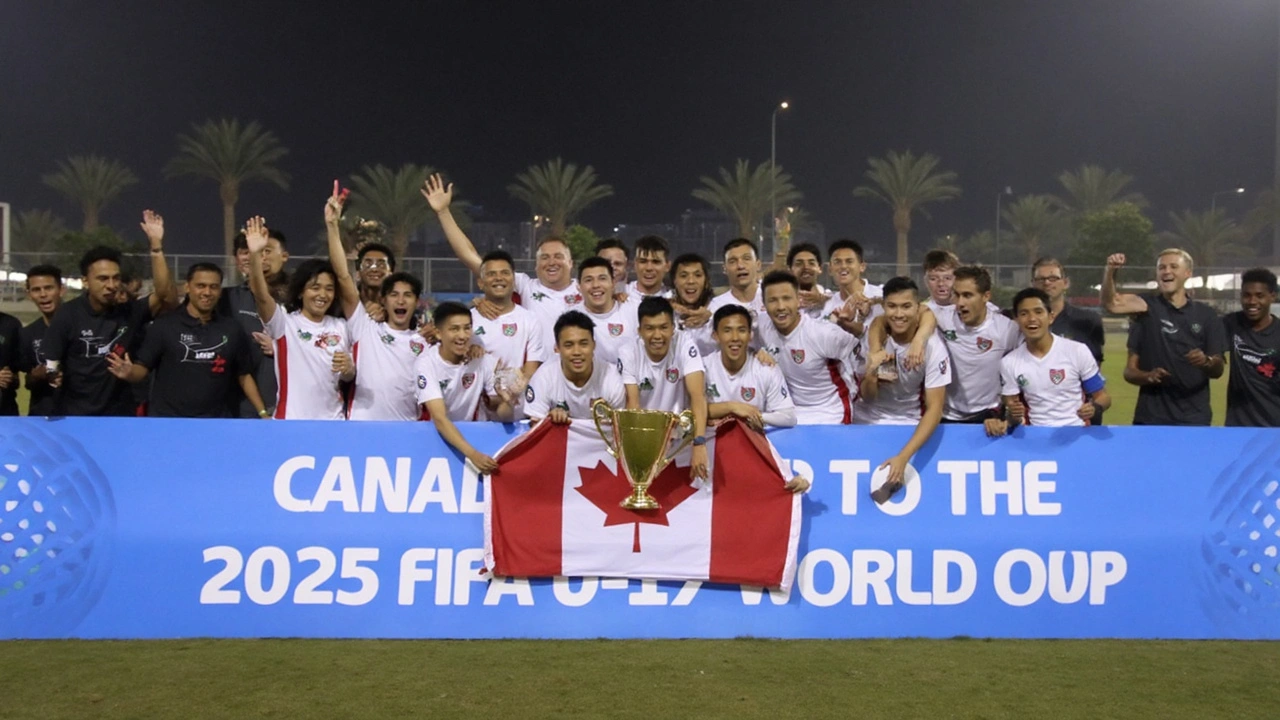Record Performances Mark CONCACAF U-17 Qualifiers
This year’s CONCACAF U-17 qualifiers had no shortage of big moments, wild scorelines, and standout performances. With the dust finally settling, Canada, Costa Rica, Mexico, and Haiti have punched their tickets to join the world’s best at the 2025 FIFA U-17 World Cup in Qatar. They round out a strong set of eight CONCACAF teams, joining the United States, Panama, El Salvador, and host nation Qatar in next year’s main event.
Let’s talk about Canada. They didn’t just qualify; they made a statement. Smashing in 28 goals across the tournament, the Canadian youth squad broke their own record set back in 1992. Their fiery 7-1 win over Bermuda turned heads, especially thanks to Aidan Evans, who scored four times in a single match. This goal spree wasn’t just a pad to the stats — it shows the evolution of Canada’s youth program, which has struggled for consistency on the world stage in the past. After this display, hope is soaring for a deep run when the World Cup kicks off in Qatar.
Elsewhere in Group A, Curaçao made noise with a 4-2 takedown of Anguilla. Jerremy Ortela stole the show, notching two early assists and scoring himself before halftime. D’Shawn Anastacia sealed the deal late in the second half, showing that Curaçao can be a tricky opponent even if they didn’t book a World Cup ticket this time.

Consistent Excellence from Costa Rica, Mexico, and Haiti
Costa Rica showed their familiar mix of discipline and flair. With ten points gathered over four matches, their defense held strong — only conceding two goals — and the attack wasn’t far behind with 21 put in the net. That’s lightning on both ends of the pitch. Since their last U-17 World Cup appearance in 2017, fans have been craving a return. Now, the Ticos come in with real momentum as they try to replicate (or better) their historical quarterfinal finishes.
Mexico and Haiti each topped their groups, steady from start to finish. The details of their group matches might be under wraps for now, but group leadership speaks for itself. Mexico never really misses a youth World Cup, but the big story here might be Haiti. Their previous best, a historic third-place qualifying finish way back in 2007, could be in the team’s sights as they barrel towards Qatar with fresh energy. For a country where sport can sometimes be an escape from daily worries, this new chance carries extra weight.
This qualifying cycle wasn’t just about the favorites. Younger players were out to make their mark, new rivalries sparked, and every coach had to adjust on the fly. While Bermuda tasted a heavy defeat to Canada, and Anguilla struggled to hold back Curaçao’s attack, both nations will look to regroup and rethink youth development ahead of the next cycle.
Now, eight CONCACAF nations stand ready to take on the world in Qatar. There’s no telling who’ll become the next breakout star, but after this round, we know one thing for sure: the region is bursting with talent and hungry for global respect.

Mohit Singh
June 5, 2025 AT 18:05Canada’s 28‑goal haul is a clear sign they’re finally reading the playbook on developing attacking talent; the way they dismantled Bermuda shows a side that can actually execute under pressure.
Damian Liszkiewicz
June 8, 2025 AT 19:42It’s exciting to see the CONCACAF region stepping up, and Canada’s performance could inspire the younger squads across the continent 😊. While the numbers are impressive, what matters even more is the growth mindset that the coaches are fostering. Developing a pipeline of talent isn’t just about a single tournament; it’s about sustained investment and community involvement. The philosophy behind nurturing these players reflects a broader commitment to sport as a vehicle for personal development. Here’s hoping the momentum carries over into Qatar, and that the fans get to witness some truly memorable matches. 🌟
Angela Arribas
June 11, 2025 AT 21:18While the excitement is palpable, the article slips up with several grammatical oversights that could have been avoided – for instance, “their evolution…” should be “its evolution,” and “the big story here might be Haiti” needs a comma for clarity 😒.
Sienna Ficken
June 14, 2025 AT 22:55Oh, Haiti pulling a surprise run? Yeah, because every time a smaller nation gets a hot streak they instantly become World Cup dark horses – think of all the “miracle” stories we’ve ignored. Nevertheless, their recent form suggests they’ve finally stopped treating football as just an escape and are treating it as a serious program. The granularity of their youth development is improving, and that’s not just a feel‑good anecdote.
Zac Death
June 18, 2025 AT 00:32The qualification campaign has given us a panoramic view of the evolving landscape of youth soccer in North and Central America. Canada’s offensive fireworks, highlighted by Aidan Evans’ four‑goal masterpiece, demonstrate that a well‑structured academy system can produce world‑class forwards. Costa Rica’s balance of disciplined defending and creative attacking play shows that tactical flexibility remains their strongest asset. Mexico continues its tradition of consistency, proving that their scouting network still identifies and refines talent at an early age. Haiti’s resurgence is perhaps the most compelling storyline, as the nation channels its passion for the sport into a more organized framework. The performances of Curaçao and even the spirited displays from Bermuda and Anguilla remind us that every match contributes to the region’s collective growth. What truly stands out is the professionalism of the coaching staff across all squads, who have adapted their strategies game‑by‑game. The statistical surge-Canada’s 28 goals, Costa Rica’s 21, and Haiti’s solid defensive record-points to a new era of competitive balance. Young players now see a clearer pathway from local leagues to the global stage, which fuels their ambition. Fans across the continent are finally being rewarded with high‑intensity games that showcase both technical skill and tactical awareness. This excitement should translate into greater investment from federations, sponsors, and grassroots programs alike. As the teams prepare for Qatar, the focus must shift from short‑term victories to long‑term development plans. The lessons learned from this qualification cycle will serve as a blueprint for the next generation of coaches and administrators. If we maintain this momentum, the CONCACAF region could realistically vie for more than just participation-perhaps even contention for the latter stages of future World Cups. In the meantime, let’s celebrate the achievements of these young athletes and cheer them on as they embark on the global adventure that awaits.
Lizzie Fournier
June 21, 2025 AT 02:08Absolutely love the optimism here; it’s great to see the region getting the recognition it deserves.
JAN SAE
June 24, 2025 AT 03:45From a coaching perspective, the way Canada executed their high‑press, the way Costa Rica organized their backline, and the way Haiti displayed resilience are all textbook examples of how modern youth training should be implemented, and it’s encouraging to see these philosophies in action; the emphasis on technical drills, tactical awareness, and mental fortitude clearly paid dividends across the board, especially in those tight group‑stage battles, which often come down to a single moment of brilliance or composure; the data supports the notion that a balanced development program yields results, and we can’t ignore the positive impact of consistent scouting and player education; ultimately, these qualifiers set a precedent for future tournaments, and they highlight the importance of investing in qualified staff and comprehensive curricula.
Steve Dunkerley
June 27, 2025 AT 05:22The utilization of periodized training cycles and progressive overload protocols evident in Canada’s preparation aligns with contemporary sport science paradigms, thereby facilitating optimal performance peaks during the qualification window.
Jasmine Hinds
June 30, 2025 AT 06:58Let’s keep this hype alive, teams! 🌟
Madison Neal
July 3, 2025 AT 08:35The collaborative ecosystems emerging across CONCACAF federations are fostering talent pipelines that could redefine competitive standards on the world stage.
John Crulz
July 6, 2025 AT 10:12Observing the strategic variations among the qualified squads highlights how diverse coaching philosophies can coexist successfully within the same confederation.
Anita Drake
July 9, 2025 AT 11:48The representation of nations like Haiti and Costa Rica adds rich cultural narratives to the tournament, enriching the global football tapestry.
Eduardo Lopez
July 12, 2025 AT 13:25While celebrating these achievements, we must also acknowledge the broader socio‑economic disparities that still hinder many aspiring players across the region; it’s not enough to simply bask in momentary glory without addressing systemic inequities.
Nancy Perez de Lezama
July 15, 2025 AT 15:02Overall, the qualifiers were a solid showcase of emerging talent.